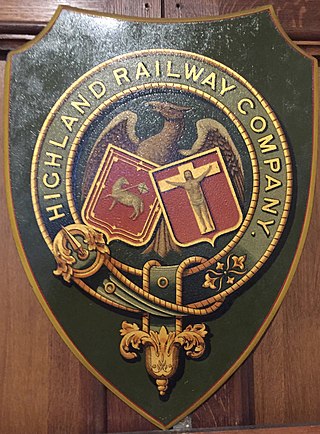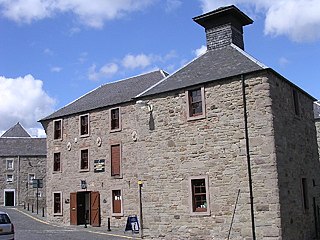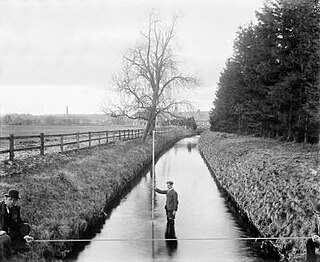
Perth is a centrally located Scottish city, on the banks of the River Tay. It is the administrative centre of Perth and Kinross council area and is the historic county town of Perthshire. It had a population of about 47,430 in 2018.

The Royal Mile is a succession of streets forming the main thoroughfare of the Old Town of the city of Edinburgh in Scotland. The term was first used descriptively in W. M. Gilbert's Edinburgh in the Nineteenth Century (1901), describing the city "with its Castle and Palace and the royal mile between", and was further popularised as the title of a guidebook by R. T. Skinner published in 1920, "The Royal Mile (Edinburgh) Castle to Holyrood(house)".

Auchterarder is a town north of the Ochil Hills in Perth and Kinross, Scotland, and home to the Gleneagles Hotel. The 1+1⁄2-mile-long (2.5-kilometre) High Street of Auchterarder gave the town its popular name of "The Lang Toun" or Long Town.

The Highland Railway (HR) was one of the smaller British railways before the Railways Act 1921, operating north of Perth railway station in Scotland and serving the farthest north of Britain. Based in Inverness, the company was formed by merger in 1865, absorbing over 249 miles (401 km) of line. It continued to expand, reaching Wick and Thurso in the north and Kyle of Lochalsh in the west, eventually serving the counties of Caithness, Sutherland, Ross & Cromarty, Inverness, Perth, Nairn, Moray and Banff. Southward it connected with the Caledonian Railway at Stanley Junction, north of Perth, and eastward with the Great North of Scotland Railway at Boat of Garten, Elgin, Keith and Portessie.

Bridge of Earn is a small town in Perthshire, Scotland. Often referred to simply as 'The Brig'. The village grew up on the south bank of an important crossing of the River Earn, whose sandstone bridge existed from at least the early 14th century, when it is known to have been repaired by order of King Robert I of Scotland (1306–1329). Substantial remains of the medieval bridge survived into the 1970s, when almost all the stonework was demolished, for (allegedly) being in a dangerously ruinous condition. This ancient bridge was a major landmark on the road between Edinburgh and Perth for several centuries. The village's oldest houses are to be found lining the road leading south from the site of the demolished bridge. Among them are some with 18th-century datestones.

Bo'ness railway station is a heritage railway station in Bo'ness, Falkirk, Scotland. It is not the original Bo'ness railway station, which was located roughly a quarter mile west on Seaview Place, now the site of a car park.

Perth Bridge is a toll-free bridge in the city of Perth, Scotland. A Category A listed structure, it spans the River Tay, connecting Perth, on the western side of the river, to Bridgend, on its eastern side, carrying both automotive and pedestrian traffic of West Bridge Street. An earlier bridge was demolished at the same location in 1621, and many unsuccessful attempts were made to replace it. A subscription was started by James VI and several noblemen to help with the construction cost, but the king's death in 1625 suspended the scheme and a series of ferryboats were instead used.

Hippolyte Jean Blanc was a Scottish architect. Best known for his church buildings in the Gothic revival style, Blanc was also a keen antiquarian who oversaw meticulously researched restoration projects.

Perth City Hall is a civic building in King Edward Street, Perth, Scotland. Built in 1914, it is a Category B listed building.

The Municipal Buildings are a municipal facility at Nos. 1, 3 and 5 High Street, Perth, Scotland. The facility is a Category B listed building.

Lower City Mills is part of a cluster of former watermill buildings, collectively known as City Mills, in Perth, Scotland. It was given Category A listed status in 1965 by Scotland's Ancient Monument Division. Milling has taken place at the location since the 14th century.

Perth Lade is an historic 4.5 mi (7.2 km)-long watercourse in Perth and Kinross, Scotland. Created in the 11th century or earlier, it has been used to power several watermills, such as those that functioned at Perth's Lower City Mills, which have existed since the 18th century. Over its course, at least nineteen industrial sites existed; today, the remains of nine of these can be seen, the rest lost to inner-city development and housing schemes of the 20th and 21st centuries. A footpath follows the majority of the lade's course.

Bridgend is a village near Perth, Scotland, approximately 0.25 miles (0.40 km) east of the city centre, on the eastern banks of the River Tay. It is in Kinnoull parish. A settlement has existed here since at least the 16th century.

The vennels of Perth are a collection of small medieval streets in the city of Perth, Scotland. Similar to York's Snickelways, vennels are a public right-of-way passageway between the gables of buildings which can, in effect, be a minor street. In Scotland, the term originated in royal burghs created in the twelfth century, the word deriving from the Old French word venelle meaning "alley" or "lane". Unlike a tenement entry to private property, known as a "close", a vennel was a public way leading from a typical high street to the open ground beyond the burgage plots. The Latin form is venella, related to the English word "funnel".

Tay Street is a major thoroughfare, part of the A989, in the Scottish city of Perth, Perth and Kinross. Planned in 1806 and completed around 1885, it is named for the River Tay, Scotland's longest river, on the western banks of which it sits. The street runs from the confluence of West Bridge Street and Charlotte Street in the north to a roundabout at Marshall Place and Shore Road in the south. Three of the city's four bridges that cross the Tay do so in this stretch : Perth Bridge, Queen's Bridge and the single-track Tay Viaduct, carrying Perth and Dundee trains to and from Perth railway station, located 0.5 miles (0.80 km) to the north-west.

High Street is a street and the primary retail area of the Scottish city of Perth. Established in at least the 15th century, its central section has been both modernised and pedestrianised, while its two ends are mainly Victorian in terms of their composite buildings. It runs for about 0.5 miles (0.80 km), from Tay Street in the east to Caledonian Road in the west.

South Street is a prominent street in the Scottish city of Perth, Perth and Kinross. Established in at least the 15th century, it runs for about 0.5 miles (0.80 km), from the Dundee Road in the east to County Place in the west, passing through the entire breadth of the city. Queen's Bridge, completed in 1960 and opened by Queen Elizabeth II, carries South Street across the River Tay to and from Kinnoull.

Watergate is a street in the city of Perth, Scotland. Along with Skinnergate, it is one of the oldest streets in the city. It runs for around 0.12 miles (0.19 km) from High Street in the north to South Street in the south. It runs parallel to Tay Street to the east and St John Street to the west. At South Street, the road becomes Speygate, the former site of Gowrie House.



















